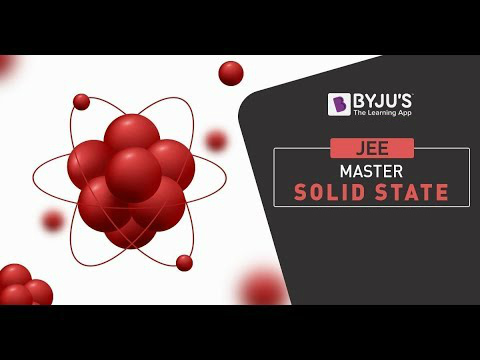A Solid in Which the Atoms Are Arranged in a Pattern That Repeats Again and Again
How are Solids Classified?
A solid interface is divers as a few atomic layers that divide ii solids in intimate contact with one some other, where the properties differ significantly from those of the bulk textile it separates.
Table of Contents
- Classification of Solids
- What are Crystalline Solids?
- What are Amorphous Solids?
- Recommended Videos
- Fundamental Features of Crystalline and Amorphous Solids
- Frequently Asked Questions – FAQs
Based on their crystal structures, solids tin be classified into the following categories:
- Crystalline solids
- Amorphous solids
However, crystalline solids can be further classified into molecular, ionic, metallic, and covalent solids. A brief introduction to the classification of solids is provided in this article.
Classification of Solids – Crystalline and Amorphous Solids
An illustration detailing the nomenclature of solids is provided beneath.

What are Crystalline Solids?
The solids featuring highly ordered arrangements of their particles (atoms, ions, and molecules) in microscopic structures are called crystalline solids.
These ordered microscopic structures make up a crystal lattice that accounts for the structure of the solid at whatsoever given point. Examples of crystalline solids include salt (sodium chloride), diamond, and sodium nitrate.
What are Amorphous Solids?
The solids in which the particles are not bundled in whatever specific club or the solids that lack the overall order of a crystal lattice are called baggy solids.
The term 'amorphous' , when broken downwardly into its Greek roots, tin can be roughly translated to "without form" . Many polymers are baggy solids. Other examples of such solids include glass, gels, and nanostructured materials.
An ideal crystal is defined as an diminutive system that has infinite translational symmetry in all the three dimensions, whereas such a definite definition is not possible for an ideal amorphous solid (a-solid).
Recommended Videos

Primal Features of Crystalline and Baggy Solids
- Nature:
Crystalline Solids – Truthful Solids
Baggy Solids – Pseudo – Solids or super-cooled liquids
- Geometry:
Crystalline Solids – Particles are arranged in a repeating pattern. They have a regular and ordered arrangement resulting in a definite shape.
Amorphous Solids – Particles are bundled randomly. They practise not have an ordered arrangement resulting in irregular shapes
- Melting Points
Crystalline Solids – They have a sharp melting point
Amorphous Solids – They practise not have sharp melting points. The solid tends to soften gradually over a temperature range
- Heat of Fusion: (The change in enthalpy when a substance is heated to change its state from solid to liquid.)
Crystalline Solids – They accept definite heat of fusion.
Baggy Solids – They do non accept definite estrus of fusion
- Isotropism:
Crystalline Solids – Anisotropic in nature. i.east., the magnitude of physical properties (such every bit refractive index, electrical conductivity, thermal conductivity etc) is unlike forth with different directions of the crystal.
Amorphous Solids – Isotropic in nature. i.e., the magnitude of the concrete properties is the same forth with all directions of the solid.
- Cleavage Holding
Crystalline Solids – When cut with a abrupt edge, the 2 new halves volition accept smooth surfaces
Baggy Solids – When cutting with a abrupt border, the 2 resulting halves will take irregular surfaces
- Rigidity:
Crystalline Solids – They are rigid solids and applying mild forces will non distort its shape.
Amorphous Solids – They are not rigid, so mild furnishings may change the shape.
Frequently Asked Questions – FAQs
What is meant by crystalline solids?
Crystalline solids consist of atoms, ions, and molecules arranged in a strongly ordered microscopic arrangement in consistent and repeated three-dimensional structures, forming a crystal lattice that stretches in whatever direction.
What are the 7 types of crystals?
7 crystal structures are available in total: triclinic, monoclinic, orthorhombic, tetragonal, trigonal, hexagonal, and cubic. A family of crystals is determined past groupings of lattices and lines.
Is coal crystalline or amorphous?
Graphite is one of 3 types of carbon which is crystalline, or crystal-forming. In compounds similar coal and charcoal, carbon also occurs every bit an amorphous, or "shapeless," course. Allotropes are called varying variants of the aforementioned substance. Some allotropes of crystalline carbon are, bated from graphite, diamond and fullerenes.
Is a diamond a crystal?
Diamond is the solid shape of the carbon molecule with its atoms bundled in a crystal arrangement called a cubic diamond. Diamond also has relatively loftier optical dispersion (chapters to besprinkle various wavelengths of light). Many natural diamonds have age ranging from 1 to 3.v billion years.
Is woods baggy or crystalline?
Crystalline solids are made of rock, wood, paper and cloth. Such solids consist of atoms bundled in a particular mode. The transition to liquid, called melting, is sharp and transparent equally crystalline solids are heated. Amorphous solids are fabricated of safety, glass and sulphur.
Have a pressing uncertainty regarding the subject? Try the alive conversation for whatsoever questions anytime and our consultants volition get back to you.
Source: https://byjus.com/chemistry/classification-of-solids-based-on-crystal-structure/
0 Response to "A Solid in Which the Atoms Are Arranged in a Pattern That Repeats Again and Again"
Post a Comment